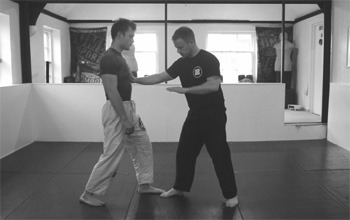Forging the body, resetting your baseline
As a martial art, Aunkai built its name on the importance of conditioning and forging the body. And rightly so, as the various exercises of the method practiced in solo or with a partner, result in the development of a strong martial body, able to generate and receive absurd amounts of force.
But the essence of practice, however, is not to become stronger. It is to make us move better, in a way that is more appropriate to martial arts. And that means resetting your baseline.
First, get in line
In the first stages of practice, emphasis is put on setting up the frame and understanding the importance of alignments. This is fundamental. However, I do believe this can be highly ineffective without removing some of the obstacles that break our alignments on a daily basis.
On top position of these obstacles come our shoes. With 33 joints, 26 bones and 4 layers of muscles each, our feet are marvels of technology… that we voluntarily destroy by putting them in shoes that are stiff, narrow, thick and… throwing us out of alignment! Ever hard that we « need to have a small heel » ? That would make us the only species in the animal kingdom born out of alignment and needing shoes to fix us.
The reality is our body is made to be barefoot, and the value of shoes mainly comes from protecting us from outside dangers. These dangers are real but absolutely do not require to have a positive heel, or a toe spring. If you know me and have attended some of my classes, you know I hold a personal grudge against shoes, but let’s not make it personal here: positive heels throw your body forward, forcing you to adjust your posture at every joint to remain vertical. Even with the best intentions in the world, you cannot get a proper posture and alignment in these conditions.
High heels only amplify the impact
And that’s not all that’s happening. Your bones and tissues are naturally loaded with whatever weight is put on them, all day long, and that helps maintain and develop healthy tissues and bone density. Being thrown out of alignment means that by default your bones and tissues do not get the load they should, and hence get weaker than they should be.
You also probably know of my grudge against chairs (I have a lot of grudges). And again, the problem is not just chairs in general but their consequences on our alignment. Being stuck for hours everyday in a sitting position, for decades has a massive impact on our tissues, such as hamstrings getting shorter, pulling our pelvis under and impacting the muscles and connective tissues upstream.
Why does that matter?
It might look like I’m ranting, but these really matter. For martial arts of course, but also more generally for our life and health on the long run.
Practicing martial arts, solo tanren, yoga, or any other physical practice for a couple of hours a day cannot compensate what we are doing for 10+ hours everyday. But changing what you do in these 10+ hours can have a massively positive impact on your health and quality of movement.
It would reset your baseline.
And your baseline is what matters the most. You can condition your body like hell, but if your baseline is horrible and your alignment is off, you will add load (in the form of weight or repetition) on top of poor quality movement, resulting in injuries on the long run.
World champion of getting injured
Martial artists have a tendency to think getting injured is not only part of the game, but also the proof they have been training well and hard. Hard, probably, but well is debatable.
Injuries can happen, and represent a constant risk in any physical activity, probably more so with one where we hit and throw each other. But accidents aside, injuries should be kept to a minimum and the reality is most people get injured not because they train hard and close to the reality, but because they move poorly. There shouldn’t be any pride in having pain all over at 40. If anything it should just raise questions on why this happened and how it could be avoided.
That’s what a good baseline does: it allows your body to deal with forces better so you do not end up loading a part of it that’s not meant for that and snaps under the constraint.
Forging the body
I strongly believe that improving our baseline should be our first priority. Of course, getting rid of chairs and shoes could help there, but we also need to be clear that this is not going to be sufficient and that time is needed to rebuild the body and bring it back to where it should be. Even more so, such adjustments cannot be sudden. If you have spent 30+ years with positive heeled shoes and switch 100% to barefoot tomorrow, you will suddenly put massive constraints on tissues that haven’t been trained for it. Chances are your calves and Achilles tendons are stiff and shorter than they should be, and a sudden and complete switch will only lead to tendonitis and other injuries. Rebuilding the body and taking back ownership takes time, but it worth it as it will give you a much stronger base to build your conditioning and your technical skills on.




Commentaires
Voili voilou.